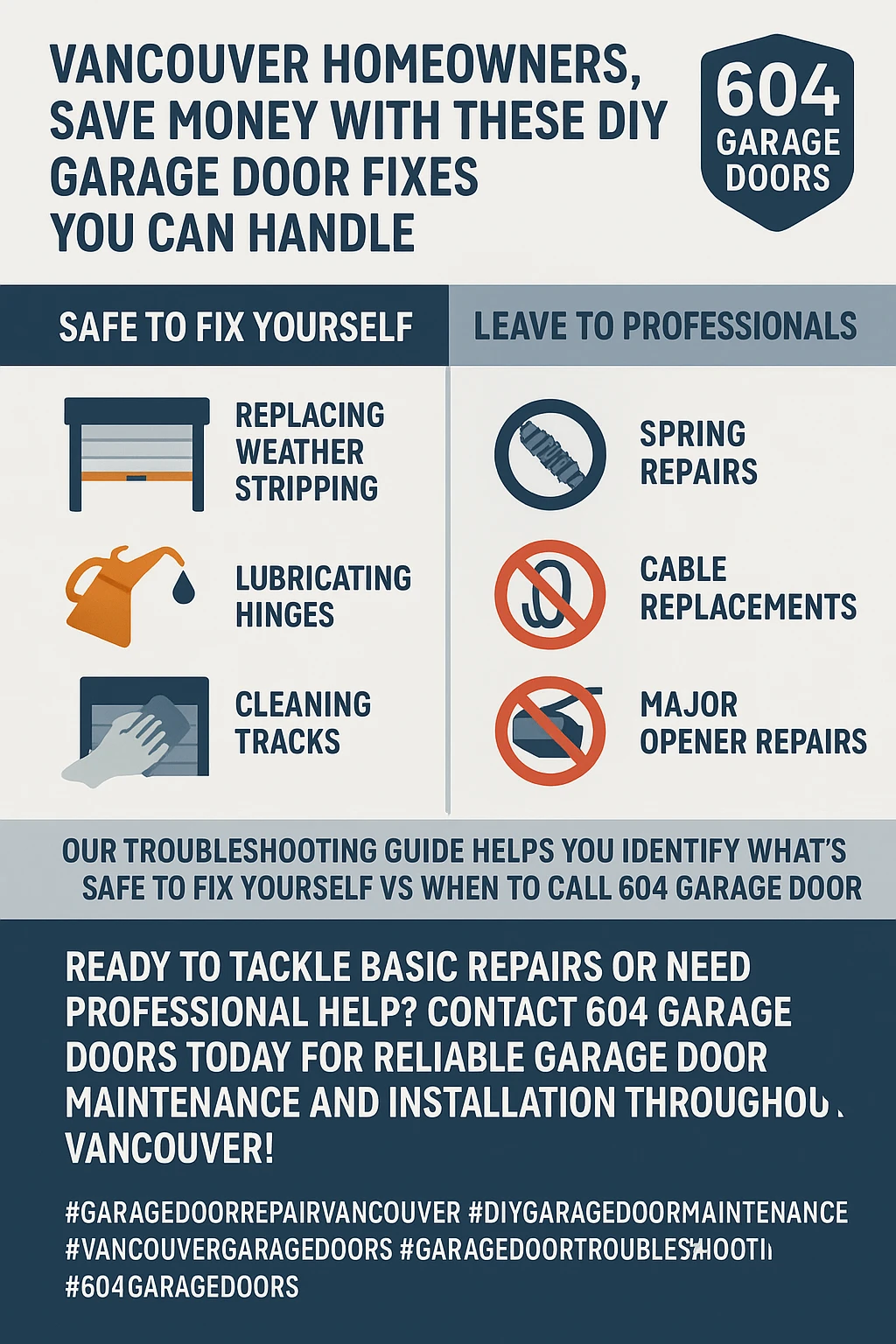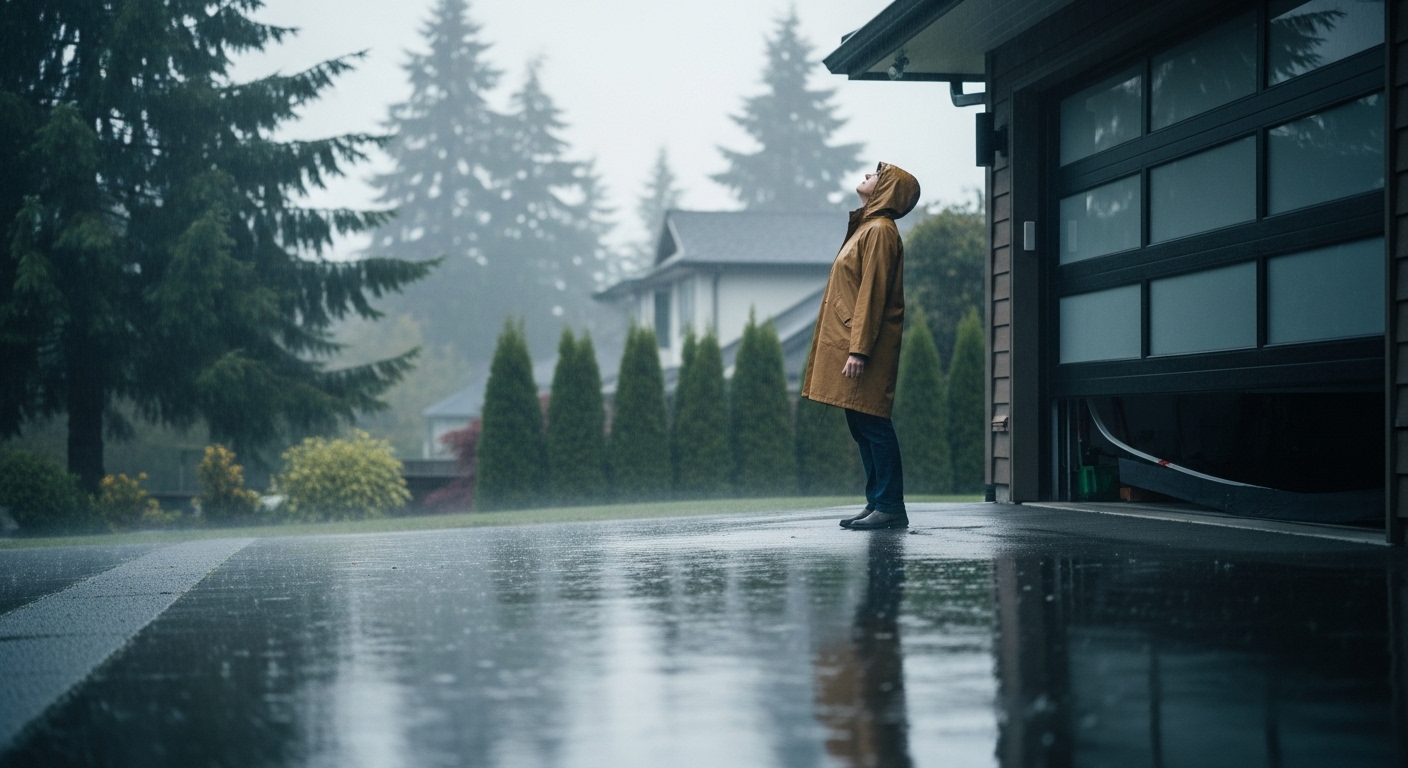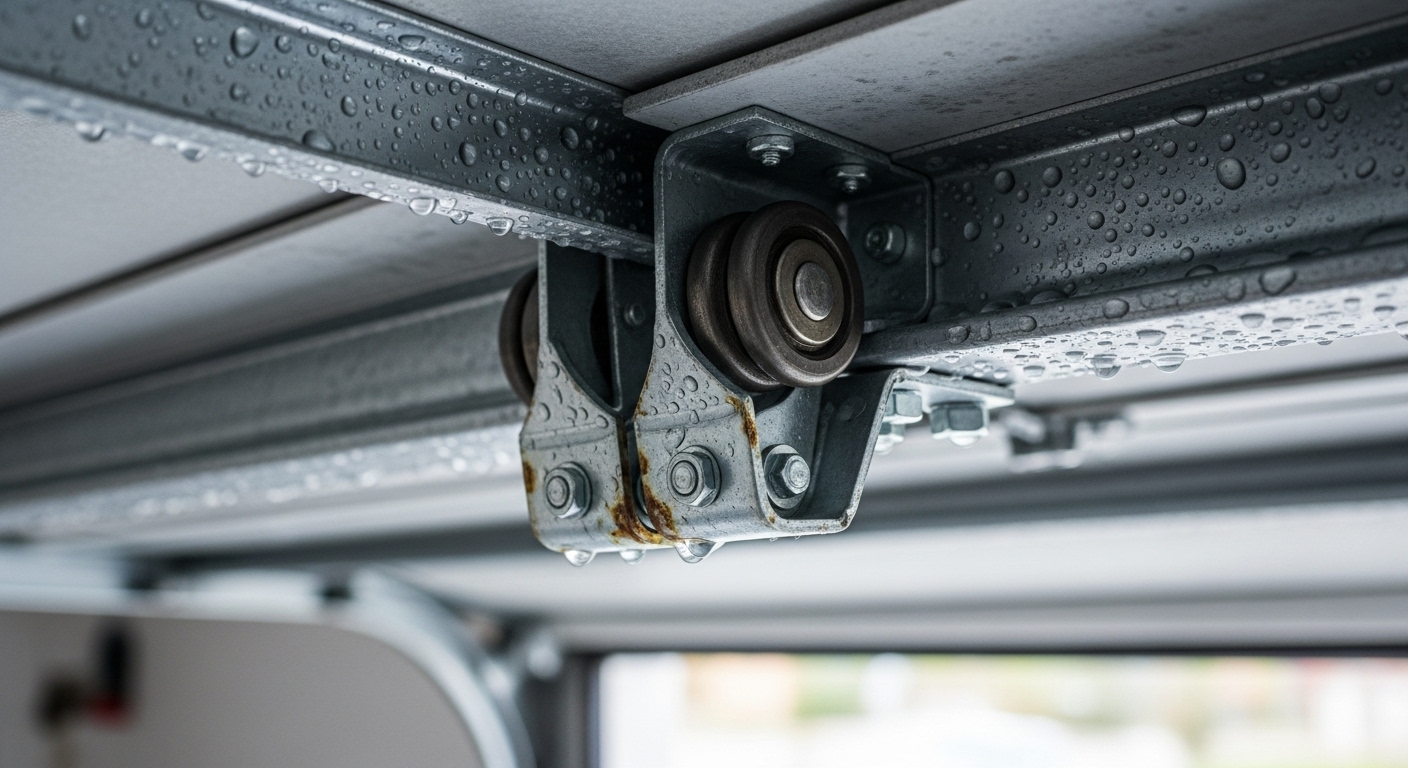DIY Garage Door Troubleshooting: 10 Problems Vancouver Homeowners Can Fix Themselves (And 5 They Absolutely Shouldn’t)
Frustrated with your garage door acting up during Vancouver’s unpredictable weather? You’re not alone – most common garage door issues can actually be fixed by homeowners with the right knowledge and safety precautions, saving you hundreds in service calls.
Picture this: it’s 7 AM on a rainy Vancouver morning, you’re running late for work, and your garage door decides to throw a tantrum. The motor hums, but nothing happens. Or maybe it starts to close, then bounces right back up like it’s playing some cruel joke. Sound familiar? As someone who’s lived through more garage door drama than I care to admit (thanks to Vancouver’s lovely combination of rain, salt air, and temperature swings), I’ve learned that knowing which problems you can tackle yourself versus when to call the pros can literally save your sanity and your wallet. Living in Vancouver means our garage doors face unique challenges that homeowners in Calgary or Toronto simply don’t deal with. The constant moisture from our coastal climate, combined with those sneaky freeze-thaw cycles we get in winter, creates the perfect storm for garage door issues. Add in the salt air that loves to corrode everything metal, and you’ve got a recipe for regular maintenance headaches. But here’s the thing – most of the problems you’ll encounter are totally manageable with basic tools and a Saturday afternoon.
The key is knowing your limits. While there are definitely some garage door problems that fall squarely in the “DO NOT attempt this unless you want to end up in the ER” category, there are plenty of others that are perfect weekend warrior territory. Understanding the difference isn’t just about saving money – it’s about keeping your family safe while maintaining that crucial barrier between your home and Vancouver’s elements.
Key Outtakes:
- Vancouver homeowners can safely handle 10 common garage door issues including remote battery replacement, sensor cleaning, lubrication, hardware tightening, and weather stripping maintenance
- Five critical problems – broken springs, cable repairs, off-track doors, major opener motor issues, and structural panel damage – always require professional intervention due to serious safety risks
- Vancouver’s coastal climate creates unique maintenance challenges with 40% higher weather stripping failure rates and accelerated component corrosion compared to drier regions
- Proper seasonal maintenance schedules adapted to Vancouver’s weather patterns can prevent 70% of emergency repair situations
- DIY maintenance can save homeowners $150-300 per service call while professional repairs for attempted DIY disasters can cost thousands

Understanding Vancouver’s Unique Garage Door Challenges
Vancouver’s garage doors don’t just deal with regular wear and tear – they’re constantly battling Mother Nature in ways that would make garage doors in Phoenix laugh. The combination of our coastal humidity, frequent rainfall, and those lovely temperature swings between seasons creates a perfect storm for garage door problems. I learned this the hard way when I moved here from Calgary and couldn’t figure out why my garage door hardware kept loosening every few months. 
The reality is that Vancouver’s climate accelerates almost every type of garage door wear you can imagine. Metal components corrode faster thanks to the salt air drifting in from the ocean. Weather stripping deteriorates at rates that would shock homeowners in drier climates – we’re talking about replacement needs that come 40% sooner than normal. And don’t even get me started on what happens to springs and cables when they’re constantly expanding and contracting with our mild but unpredictable temperature changes.
What makes this even more challenging is that many Vancouver neighborhoods feature older homes with garage door systems that predate modern weatherproofing and safety standards. Walk through Kitsilano, Commercial Drive, or Mount Pleasant, and you’ll find plenty of garage doors that were installed when Jimmy Carter was president. These older systems lack the corrosion resistance and weather sealing that modern doors take for granted, making them even more susceptible to Vancouver’s climate challenges.
The moisture factor can’t be overstated. While we don’t get the brutal cold that destroys garage doors in Winnipeg, our constant dampness creates its own set of problems. Sensors get dirty faster, tracks collect more debris, and electronic components face constant humidity stress. Understanding these local factors isn’t just academic – it directly impacts how often you’ll need to perform maintenance and which problems you’re most likely to encounter.
The 10 DIY-Friendly Garage Door Problems
Now for the good news – most of the garage door problems you’ll face as a Vancouver homeowner are totally manageable with basic tools and weekend warrior attitude. These ten issues represent probably 80% of the service calls that local garage door companies receive, and honestly, most of them are easier to fix than assembling IKEA furniture. 
Remote Control Battery Replacement and Programming
Let’s start with the most common culprit – dead remote batteries. If your wall button works fine but your remote acts like it’s on strike, you’re probably looking at a simple battery swap. Vancouver’s humidity can actually shorten battery life by about 25% compared to drier climates, so don’t feel bad if you’re replacing batteries more often than the manual suggests.
The process is straightforward: pop open the back of your remote, note the battery type (usually a coin-style battery), and swap in a fresh one. Here’s where it gets slightly tricky – many newer openers require you to reprogram the remote after battery replacement. This involves pressing the “learn” button on your opener motor unit and following the manufacturer’s sequence. Keep your owner’s manual handy, and if you’ve lost it, most manufacturers have them available online.
Sensor Cleaning and Alignment
Those little sensors at the bottom of your garage door opening are basically the safety cops of your garage door system. They’re positioned about six inches off the floor on each side, creating an invisible beam that prevents the door from closing on anything important – like your car, your dog, or your teenager who’s trying to sneak in after curfew.
Vancouver’s environment loves to mess with these sensors. Rain creates water spots, spiders build webs across them, and general dust and debris accumulate on the lenses. When sensors are dirty or misaligned, your door will typically start closing but then reverse before reaching the floor, often with the opener lights blinking like a disco. Cleaning is simple – use a soft microfiber cloth to gently wipe the lens surfaces. For alignment, ensure both sensors point directly at each other with steady green indicator lights.
Lubrication of Moving Components
This is probably the single most effective maintenance task you can perform, and it’s easier than maintaining your car. Vancouver’s salt air and moisture make regular lubrication absolutely critical – I learned this when my garage door started sounding like a haunted house soundtrack every time I used it.
Focus on hinges, roller bearings (metal rollers only – never lubricate nylon rollers), torsion springs, and the opener rail. Use silicone-based sprays or white lithium grease specifically designed for garage doors. These products resist dirt attraction and provide long-lasting protection against our coastal moisture. Proper lubrication can cut garage door noise by half while significantly extending component life. Plan on doing this every six months, or more frequently if you’re close to the water.
Hardware Tightening and Inspection
Vancouver’s temperature swings cause garage door hardware to play a constant game of expand-and-contract, which gradually loosens bolts, screws, and mounting brackets. With over 1,000 opening and closing cycles per year in a typical home, those vibrations add up to create loose connections throughout the system.
The inspection process involves checking all visible nuts and bolts for tightness, examining mounting brackets for stability, and ensuring track alignment stays proper. Focus on track mounting brackets, hinge bolts, and roller brackets that show signs of movement or wear. This is particularly important after severe weather events that might stress the system through wind loading or rapid temperature changes. A quarterly inspection schedule works well for most Vancouver homes, with additional checks after storms.
Weather Stripping Replacement
Vancouver’s constant moisture exposure combined with UV damage from our summer sun creates accelerated weather stripping deterioration. This isn’t just about energy efficiency – damaged weather stripping allows water infiltration, increases heating costs, and creates entry points for pests that nobody wants sharing their garage space.
You can assess weather stripping condition by checking for visible light gaps under the closed door or noting water, debris, or unwelcome critters infiltrating your garage. Replacement involves measuring your door width, purchasing appropriate weather stripping from local hardware stores like Home Depot or Canadian Tire, and installing the new material in the door’s bottom retainer channel. Look for weather stripping specifically designed for coastal climate conditions, which offers improved UV and moisture resistance.
Noise Reduction Through Maintenance
Garage door noise complaints spike


